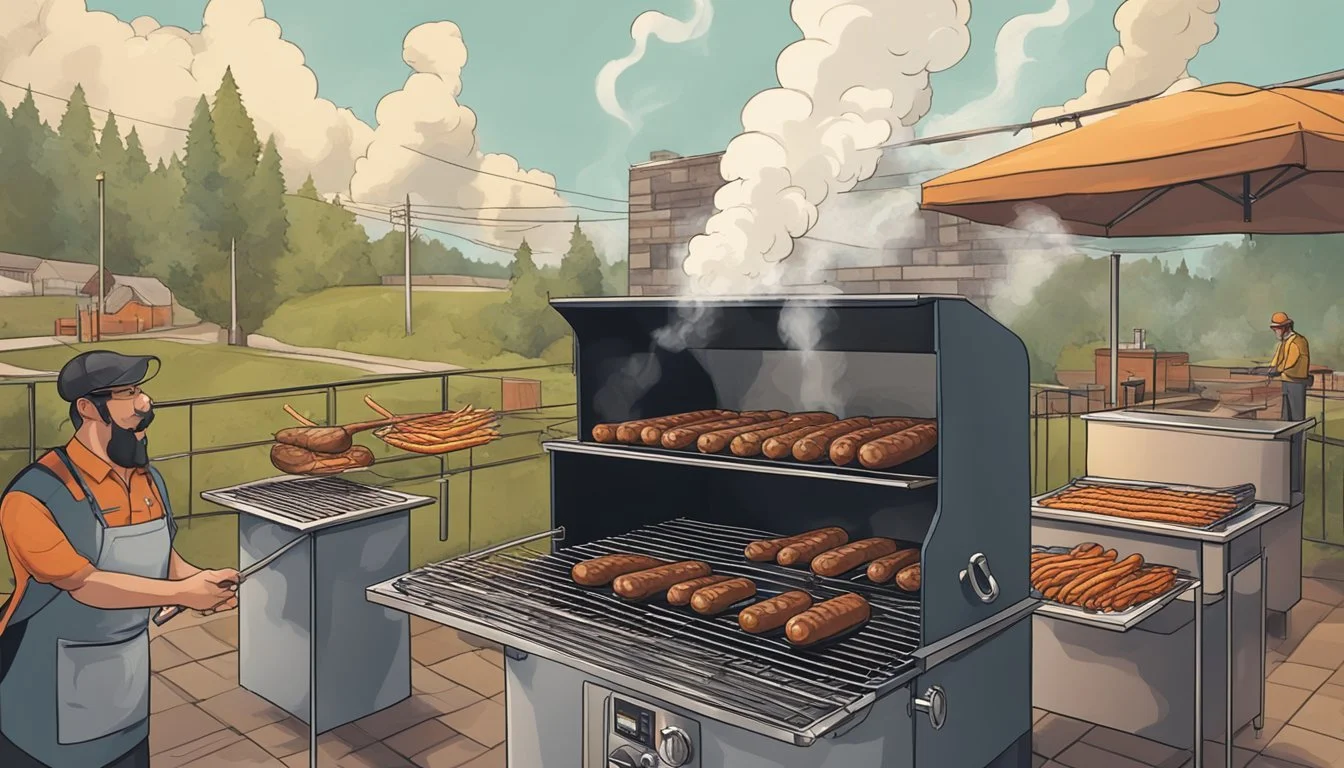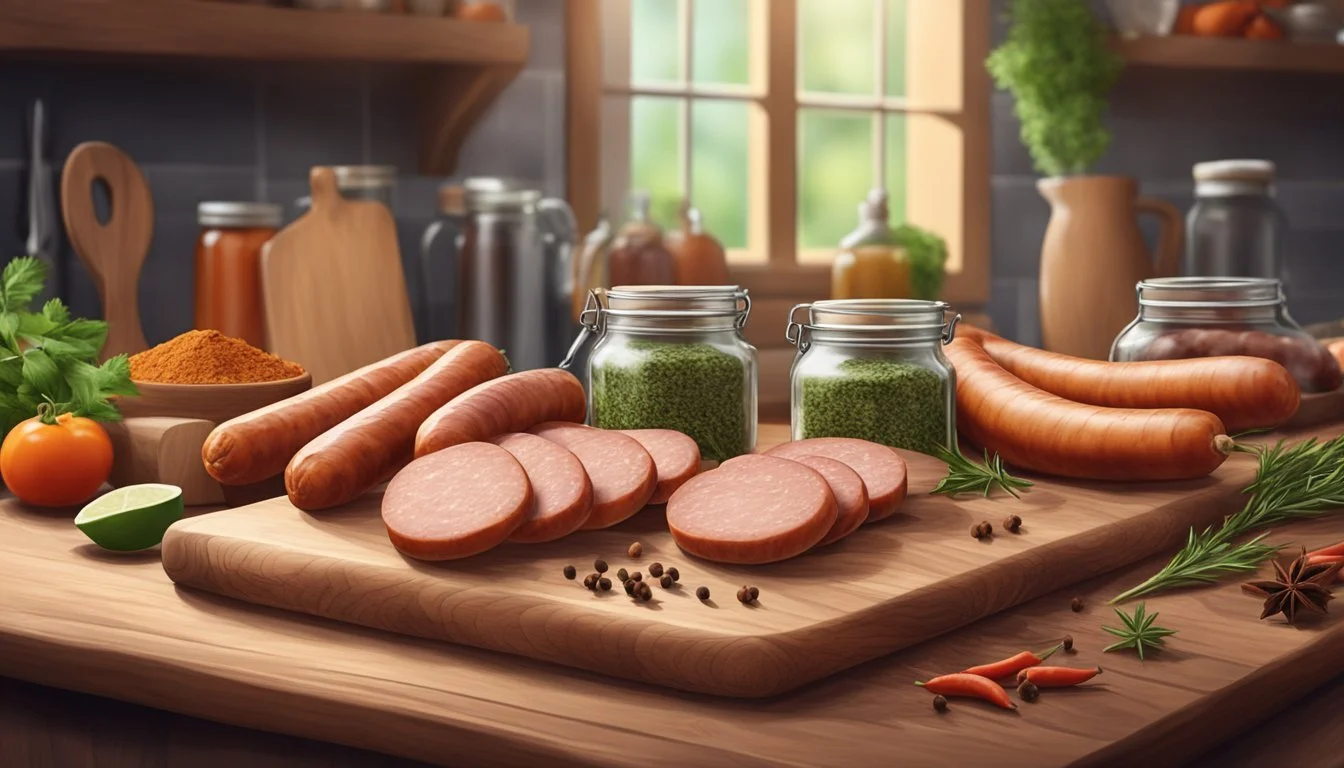Smoked Sausages at Home
Master the Art of DIY Charcuterie
Smoking sausages at home infuses them with rich flavors and a delectable aroma that can't be achieved through other cooking methods. This culinary technique, which involves cooking the sausages low and slow in the presence of wood smoke, is a tradition rooted in preserving meats before refrigeration was commonplace. Now, it's a favorite practice among food enthusiasts to impart a unique taste and tender texture. By controlling the smoke level, the type of wood used for the fire, and the cooking time, home smokers can customize the flavor to their liking.
The process begins with setting the smoker to the right temperature, usually between 225°F and 250°F. This is the sweet spot for ensuring sausages are cooked thoroughly without losing moisture. While various smokers have different features and fuel sources, the objective remains the same: to cook the sausages to an internal temperature of 165°F, which is considered safe for consumption according to food safety guidelines. The size of the sausages can affect cooking times with larger varieties like bratwurst taking approximately 2 to 3 hours and thinner types often ready in about 1 ½ hours.
Timing and temperature are paramount, but so is the preparation of the sausages before they hit the grates. Starting with sausages right out of the refrigerator, without letting them come to room temperature, helps to maintain the desired texture. Spacing is also crucial; ensuring they are set an inch or so apart allows for an even distribution of smoke and heat. Once these crucial steps are taken care of, the smoker does the rest of the work, enveloping the sausages in a warm, smoky environment that leads to flavorful and succulent results.
Essentials of Sausage Smoking
Successfully smoking sausages at home requires a solid understanding of the smoking process, careful selection of woods that impart desired flavors, and choosing the right type of sausages.
Understanding Smoking Basics
Smoking involves cooking food at low temperatures in a controlled, smoky environment for an extended period. It imparts a distinct flavor and increases the shelf life of smoked sausages. Consistent temperature control is crucial; typically, the smoker should be preheated to around 225 °F. Smoke levels should be sufficient but not excessive, as too much smoke can make the sausages bitter.
Selecting the Right Wood for Smoking
The type of wood used for smoking greatly influences the flavor of the sausage. Hardwoods are preferred for their clean-burning properties and flavor profiles.
Wood Type Flavor Profile Hickory Strong, bacon-like Mesquite Intense, earthy Oak Medium, robust Pecan Mild, sweet, nutty Apple Light, fruity Cherry Mild, sweet, fruity
It's advisable to avoid softwoods as they can impart an unpleasant taste and may contain harmful resins.
Choosing Sausages for Smoking
The best sausages for smoking are those with high fat content, as they remain moist during the long smoking process. Sausages should be placed on the smoker racks with at least an inch of space between them to ensure even smoke penetration. One must ensure that the sausage reaches an internal temperature of 165°F for safe consumption.
Preparing Your Sausages for Smoking
The initial steps in smoking sausages involve selecting the right meat, crafting a flavorful spice blend, and mastering the stuffing process to ensure a final product that is both delicious and has the perfect texture.
Sausage Selection and Preparation
When preparing to smoke sausage, the selection is crucial. One can choose between Italian sausage, breakfast sausage, chorizo, kielbasa, bratwurst, andouille, chicken sausage, pork sausage, and turkey sausage. Each variety brings a unique flavor profile to the table. For smoking, it's important to select sausages with a high-quality meat content and a balance of fat – roughly a 30% fat ratio is ideal for maintaining moisture.
Creating the Perfect Spice Mix
The spices one chooses will define the character of the homemade sausage. The spice mix should complement the type of sausage being made. Here are simple spice mix suggestions for different sausage types:
Italian Sausage: Fennel seeds, paprika, garlic powder
Chorizo: Chili powder, smoked paprika, cumin, garlic
Kielbasa: Marjoram, garlic, black pepper
Andouille: Cayenne, thyme, paprika, garlic
For each pound of meat, one typically uses about 2 tablespoons of spice mix. It's best to mix the spices thoroughly with the meat prior to stuffing.
Sausage Stuffing Techniques
Stuffing sausage requires attention to detail to avoid air pockets, which can affect the cooking process. One should gently feed the seasoned meat into the sausage stuffer and fill the casing evenly, leaving space at both ends to twist and seal the sausages. For best results in a smoker, sausages should not be overstuffed as they need some give to absorb smoke and develop flavor.
Operating Your Smoker
When smoking sausages at home, understanding your smoker's functionality and managing the heat are crucial. Different smoker types require specific methods of preheating and temperature control to ensure perfect results.
Smoker Types and How to Use Them
Charcoal smokers operate by burning charcoal with hardwood or wood chips for flavor. To use them, they should start with a chimney starter to ignite the charcoal evenly before transferring it to the smoker's firebox. It's essential to maintain a consistent airflow for temperature control.
For gas smokers, which use propane, the key is to ensure a steady gas supply and to use the control knob to adjust the flame. This type of smoker often has a push-button ignition for convenience.
Electric smokers maintain the desired temperature using an electric heating element. One should ensure that the smoker is connected to a reliable power supply. The wood chips in an electric smoker are typically placed in a designated tray or pan above the heating element.
Preheating Your Smoker
Preheating ensures that the smoker reaches the ideal internal temperature before sausages are introduced. For charcoal smokers, this involves allowing the coals to ash over, which usually occurs when they turn light grey. In the case of gas and electric smokers, one simply sets the desired temperature and waits until the smoker indicates that it has been steadied.
Preheat temperatures: Aim for a range of 225°F to 250°F for optimal sausage smoking.
Temperature Management
Maintaining a constant temperature during smoking is vital for flavor development and food safety. Use the built-in thermometer in your smoker; if it doesn’t have one, invest in an instant-read meat thermometer or a probe that can remain in the grill during the whole process. Check the internal temperature periodically, as fluctuations can occur due to various factors such as outside temperature, wind, or how often the smoker is opened.
Temperature adjustment tips:
For charcoal smokers: Add or reduce coals, and adjust the air vents to control the air flow and heat.
For gas smokers: Fine-tune the control knob to regulate the flame.
For electric smokers: Set the thermostat to adjust the heating element as needed.
One should place sausages on smoker racks with enough space between them to ensure even smoking and remember that foods closer to the heat source will cook quicker. Keep an eye on the internal temperature of the meat, aiming for a safe 160°F for pork sausages, which usually takes a few hours, depending on sausage thickness and smoker efficiency.
The Smoking Process
The smoking process enhances flavor and cooks sausages to perfection. It involves careful temperature monitoring and different techniques based on personal preference or desired texture.
Hot Smoking vs Cold Smoking
Hot Smoking: Hot smoking cooks the sausages while imparting a smoky flavor. Sausages are smoked at temperatures ranging from 225°F to 250°F. This method not only adds the desired smokiness but also brings the internal temperature of the sausage up to a safe level.
Cold Smoking: This technique flavors the sausage without actually cooking it, utilizing temperatures between 60°F and 80°F. Cold smoking can take several hours or even days and requires cured meat for food safety.
Monitoring Sausage Temperature
To ensure sausages are smoked evenly and safely, one should constantly monitor their internal temperature. The ideal target temperature for sausage is 165°F. A reliable method is to use an instant-read thermometer, inserted into the center of the sausage, away from any fillers that may skew the reading.
Tip: Consistency is key; a temperature spike can cause the fat to render out, leaving the sausage dry and less juicy.
Smoking Times and Techniques
The duration to smoke sausages typically ranges from 2 to 4 hours, depending on the thickness and type of sausage. For a flavorful and juicy outcome, here are the recommended steps:
Gradually bring the smoker to the right temperature; ideally, 225°F for hot smoking.
Place sausages on the grate, ensuring they are spaced out to allow for even smoke distribution.
Add wood chips or chunks to the smoker to create the smoke. Maintain this throughout the smoking process.
Regularly check and maintain the smoker's temperature.
Turn sausages occasionally for an even cook.
Note: Using wood such as oak or pecan can add unique flavor profiles to the sausages.
Flavor Profiles and Combinations
The mastery of smoked sausage making at home lies significantly in one's ability to match different woods and spices to create unique and tantalizing flavor profiles.
Choosing Wood and Sausage Pairings
Types of Wood Sausage Recommendations Flavor Notes Hickory Beef or Wild Game Strong, bacon-like flavor Apple Pork or Poultry Mild, fruity touch Maple Pork or Chicken Subtly sweet, smoky taste Cherry All types Slightly sweet, red-hued smoke Mesquite Beef or Game Intense, earthy undertone
Pairing the right wood with the appropriate sausage type can elevate the smoke flavor. For instance, hickory imparts a robust taste that complements the richness of beef, while apple wood offers a gentler sweetness suited to pork. Remember that woods like mesquite should be used sparingly due to their potent flavor profile.
Balancing Smoke and Spices
Achieving a harmonious blend of smoke and spices begins with understanding the individual contributions of each seasoning.
Peppers: They introduce heat and complexity; from mild bell peppers to the fierce heat of ghost peppers, there's a range to suit every palate.
Onions: A classic addition that brings a sweet and aromatic quality to the sausage.
Cheese: When adding cheese like cheddar or gouda, it can infuse richness and a creamy texture, complementing the meat's savoriness.
Mustard: It can provide tanginess and depth, acting as both a spice and a condiment.
When combining these flavors with smoke, balance is key. A subtle application of smoke allows the intricate notes of spices to shine through without overpowering them. Cheeses, due to their fat content, absorb smoke well and can act as flavor carriers within the sausage. It's essential to consider both the intensity of the smoke and the robustness of the spices to create a well-rounded flavor profile.
Post-Smoking Handling and Storage
After smoking sausages, proper handling and storage are crucial to maintain their flavor and ensure food safety. This section will cover the essential steps for resting and cooling sausages, as well as guidelines for storing them safely in the fridge or freezer.
Resting and Cooling Sausages
Once the smoking process is complete, sausages should be left to rest. This allows the flavors to meld and the juices to redistribute throughout the sausage, resulting in a better texture and taste.
Step 1: Transfer the sausages from the smoker to a clean area with minimal airflow to avoid contaminants.
Step 2: Allow the sausages to cool down to room temperature before refrigerating, which usually takes about 30 minutes to 1 hour.
Storing Smoked Sausages Safely
Proper storage is key to extending the shelf life of smoked sausages, whether they are leftovers or made in bulk. Sausages can be stored in the fridge if they will be consumed soon, or in the freezer for longer preservation.
In the Fridge:
Place the sausages in an airtight container or wrap them tightly in plastic wrap or aluminum foil.
Smoked sausages will typically last 3 to 4 days in the fridge.
In the Freezer:
For longer storage, freezing smoked sausage is a viable option. Wrap each sausage individually with cling film, then place them in a freezer bag or vacuum seal to prevent freezer burn.
Clearly label each package with the date of freezing.
Smoked sausages can be kept in the freezer for up to 3 months for best quality. However, if vacuum sealed, they may last up to 9 months.
Always thaw frozen sausages in the refrigerator overnight, rather than at room temperature, to ensure they remain safe to eat.
Serving and Reheating Smoked Sausages
When serving or reheating smoked sausages, the key is to maintain their moist, juicy quality without overcooking. Proper techniques can ensure they remain delicious and at the ideal temperature for various dishes.
Best Practices for Reheating
In the Microwave:
Arrange the sausages on a microwave-safe plate.
Cover with a damp paper towel to preserve moisture.
Heat on medium power, checking at 30-second intervals to avoid overcooking.
In the Oven:
Preheat to 350°F (175°C).
Place sausages on a baking sheet and cover with foil.
Bake for 15-20 minutes, removing the foil near the end for a crisp exterior.
On the Grill:
Preheat the grill to medium heat.
Place sausages on grates.
Turn occasionally, grilling for about 10 minutes or until heated through.
Dish Pairings for Smoked Sausage
For Breakfast:
Integrate sliced sausages into a breakfast casserole with eggs and cheese.
Serve alongside onion and pepper hash for a balanced meal.
As a Meal:
Slice into coins and add to jambalaya or gumbo for authentic Southern flavor.
Mix with mac and cheese for a comforting dish, or create a warm potato salad for a hearty side.
Incorporation into Recipes:
Include as a topping on homemade pizza for a savory bite.
Chop and stir into a spicy rice dish for additional smoky notes.
Health and Nutrition Information
When considering homemade smoked sausages, one should be mindful of their health and nutritional impact. This section provides detailed insights into the caloric and nutritional content as well as the types of fats and cholesterol levels present in smoked sausages.
Caloric and Nutritional Content
Smoked sausages are calorie-dense meat products. For example:
Calories: A 2 oz (56 g) serving of smoked sausage typically contains around 170 calories.
Fat: This same serving size generally comprises 15 g of total fat.
The macronutrient breakdown of smoked sausages on average can be tabulated as follows:
Nutrient Amount per 2 oz serving Calories 170 Total Fat 15 g Saturated Fat Determined by the type of meat and added ingredients Trans Fat Minimal if not using hydrogenated oils Cholesterol Depends on the meat cuts used Sodium Varies by recipe Carbohydrates Usually 2% or less of total content Fiber Minimal Sugars Minimal to none unless added Protein Roughly 23% of total content
Understanding Fats and Cholesterol
The fats found in smoked sausage are typically a mix of:
Saturated fat: Originates from animal fat; intake recommendation is to limit as it may raise "bad" LDL cholesterol.
Trans fat: Should be avoided; homemade sausages ideally do not contain trans fat unless using specific processed ingredients.
Unsaturated fat: This healthier fat comprises both monounsaturated and polyunsaturated fats and can be beneficial when consumed in moderation.
The cholesterol content is heavily influenced by the type of meat used in sausage-making. Poultry-based sausages usually contain less cholesterol than those made from pork or beef. One should consider the balance of these fats while preparing and consuming smoked sausages as part of a balanced diet.
Creative Recipes and Innovations
This section explores how home chefs can expand their culinary horizons by incorporating smoked sausages in creative recipes and experimenting with various international cuisines.
Innovative Smoked Sausage Recipes
Home cooks eager to experiment can try various innovative smoked sausage recipes that elevate the classic flavors. From Sweet Potato Skillet Hash that pairs the smokey taste of sausage with the sweetness of maple-glazed sweet potatoes, to Smoked Sausage Rolls that are an upgrade on traditional hot dogs, the options are diverse and mouth-watering. For those looking to maintain culinary traditions while adding a twist, crafting homemade Andouille sausage for a Cajun flair in pasta dishes (What wine goes well with pasta dishes?) can offer a robust flavor profile.
Bold Toppings: Toppings like caramelized onions or a spicy mustard sauce can transform smoked sausage into a gourmet treat.
Breakfast Links: Smaller sausage links blended with flavors like apple or maple create a delightful sweet and savory breakfast option.
Integrating Smoked Sausage into Various Cuisines
Smoked sausage is versatile and integrates seamlessly into a myriad of cuisines. In Italian cooking, incorporating sliced smoked sausage into pasta dishes along with garlic, bell peppers, and onions can blend hearty and rustic tastes. Those fond of Asian cuisine can slice smoked sausage into stir-fries or fried rice for an unexpected burst of smoky flavor. By carefully selecting the right types of smoked sausage, cooks can ensure the sausage complements rather than overpowers the dish's existing flavor palette.
Pairings with Pasta: Utilizing smoked sausage in pasta dishes as a protein enhances the savory depth of the dish.
Sausage Types by Cuisine: For Italian dishes, opt for garlic and herb-infused sausages, while for Cajun dishes, andouille sausages are ideal.
By recognizing the adaptability of smoked sausage, culinary enthusiasts can revitalize time-honored recipes and bring a new level of excitement to the dining table.






